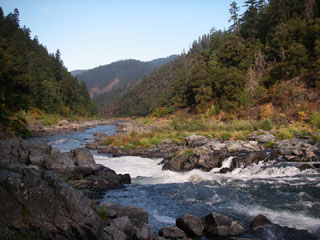The Rogue River was one of the nation's first designated Wild and Scenic Rivers. Recreational opportunities abound from the Lost Creek Reservoir to the Pacific Ocean. Several fun day trips are available downstream of Lost Creek Reservoir which now flows freely with the removal of 3 dams: Gold Ray, Gold Hill, and Savage Rapids. Now that all of these dams are gone, fish passage has been enhanced while safety and navigation have been improved. Downstream of Grants Pass the river enters a remote wild country as the carves through the Coast Range, and the Wild and Scenic section from Grave Creek to Foster Bar is known as one of the finest multi-day river trips in the country. A limited number of permits are distributed for this section. Protecting the special scenic qualities of this resource remains a priority for American Whitewater. From Foster Bar to the Pacific Ocean the river is best known as a place for jet boating and fishing with convenient roadside access for day trips.

Dam Removal
Three mainstem dams on the Rogue River between Lost Creek Reservoir and Grants Pass along with the partially completed dam on Elk Creek have impacted the flow of the Rogue River. Although this section of the Rogue is not as well known to paddlers as the world-famous Wild and Scenic section downstream, removal of the dams has improved fish passage and navigability greatly enhancing the quality of this river as a recreational resource.
Heading downstream the first dam was Gold Ray Dam. This dam was originally constructed for hydropower but generation ceased in 1972 after the project was determined to no longer be cost effective. As reported in a July 20th, 2007 editorial in the Medford Mail Tribune: The Rogue River is a jewel in our midst. Removing a dam that serves no real purpose seems like an obvious step toward making that jewel shine even more brightly. The dam was removed in the summer of 2010.
The next dam downstream was the Gold Hill Dam, a municipal water diversion that was removed in the summer of 2008. The city completed a new water intake facility upstream of the dam in May of 2006 making the old diversion dam no longer necessary.
The biggest barrier to fish migration was the Savage Rapids Dam which was operated by the Grants Pass Irrigation District. In July 2001 parties came to an agreement to suspend litigation and focus on a plan to remove the Savage Rapids Dam and install pumps that now provide the irrigation district with the water it needs. The contract to remove the dam was issued in August 2006 and work was soon underway to construct the new pumping station. The dam was removed in fall of 2009 restoring the free flow of the Rogue River at this site for the first time in decades.
In addition to these dams on the mainstem Rogue, a partially-completed dam on Elk Creek remains on this major tributary of the Rogue River. Construction on this Army Corps of Engineers flood control dam began in 1986. Construction stopped in 1988 with approximately 1/3 of the dam completed. The decision to discontinue work on this dam was the result of litigation and additional studies that demonstrated the dam did not make economic sense and would have significant impacts on salmon. For years salmon were trucked around the dam site but the dam was notched in 2008 providing unhindered fish passage and opening the river to navigation through the dam site.
Protection of the Wild and Scenic Rogue
The Rogue was one of the original eight rivers included in the Wild and Scenic Rivers Act of 1968. The 84 mile Wild and Scenic section begins 7 miles west of Grants Pass and ends 11 miles upstream of Gold Beach where the river joins the Pacific Ocean. On its journey through the the Coast Range, the Rogue flows through one of the most spectacular and biologically unique wilderness areas in the United States. Those who secure a permit are able to enjoy one of the best whitewater runs in the country with world-class fishing opportunities on trips that are typically 3-5 days in length. Only part of this section is protected through the Wilderness Act and Wild and Scenic Rivers Act. Large areas within the valley of the river that are currently roadless backcountry are open to logging, mining, and road building. Now is the time to protect these roadless areas that define the wilderness experience of the Rogue River. We served in a leadership capacity with a coalition of groups to designate a number of Rogue River tributaries as Wild and Scenic in 2019 (Public Law 116-9). We are continuing our efforts to protecting the surrounding landscape and forests along the Rogue River as Wilderness and Recreation Areas.
Other Issues
- River Management: From time to time other issues come up on this river. River managers have floated ideas for a campsite reservation system. As an alternative, they have focused on providing river runners with more accurate and comprehensive information on campsite size, encouraging groups to select a camp appropriate for their trip size.
- Navigability: The state made a navigability determination for the Rogue River not surprisingly concluding that it is navigable from the ocean to Lost Creek Reservoir.
- Jet Boat Use: The lower reaches of the Wild and Scenic section see jet boat use by the “mail boat” and downstream of Foster Bar one can expect to encounter quite a few private jet boats. This lowest section of the river has been the site of an annual jet boat race.
